General Telephones
 With a growing number of telephone subscribers to cater for and improvements
in technology so too the telephone began to become more advanced. The
rotary dial was replaced by push buttons but these early systems still used
the same technology behind the dial – so called pulse dialling. However,
with the introduction of digital technology within the telephone network
and the availability of solid-state integrated circuits, telephones became
far more advanced machines. Today’s push button telephones
use a system called Dual-Tone Multi-Frequency (DTMF) for dialling a number. Here
each pressing a key generates a unique combination of two frequencies and
can be heard as an audible tone. With this system it is not
only much quicker to dial a number but also it allowed for additional keys
such as the * and # to be introduced. Electronics within the telephone
provides for last number re-dial and the storage of commonly called numbers. Advances
in the network mean that ‘caller line identification’ allows
for the number of the person calling you to be displayed on the telephone
handset. Today the telephone network doesn’t just provide the
means by which you make telephone calls; it is your connection point to
a whole digital world
With a growing number of telephone subscribers to cater for and improvements
in technology so too the telephone began to become more advanced. The
rotary dial was replaced by push buttons but these early systems still used
the same technology behind the dial – so called pulse dialling. However,
with the introduction of digital technology within the telephone network
and the availability of solid-state integrated circuits, telephones became
far more advanced machines. Today’s push button telephones
use a system called Dual-Tone Multi-Frequency (DTMF) for dialling a number. Here
each pressing a key generates a unique combination of two frequencies and
can be heard as an audible tone. With this system it is not
only much quicker to dial a number but also it allowed for additional keys
such as the * and # to be introduced. Electronics within the telephone
provides for last number re-dial and the storage of commonly called numbers. Advances
in the network mean that ‘caller line identification’ allows
for the number of the person calling you to be displayed on the telephone
handset. Today the telephone network doesn’t just provide the
means by which you make telephone calls; it is your connection point to
a whole digital world
GPO 782R Two-tone grey push button MF dialling table telephone with recall button
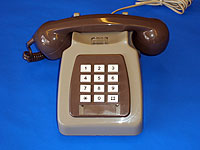 | Manufactured by PYE, Aidre (GNA) in 1981 (81/6). |
The TSR 8009A Eiger
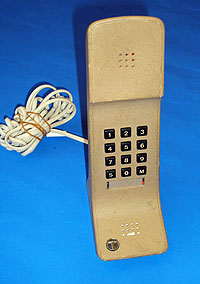 | The Eiger became available in 1981 and this version is the type A in stone coloured textured finish.
It had a last number re-dial facility and an 'S' (silent) button which cut-off the microphone. This stone coloured version was produced in 1982. It was supplied to BT by Gfeller Telecommunications of Switzerland. |
The Ambassador Telephone
 BT's next generation telephone concept was to produce a standard telephone
for the 1980s. It was marketed under the name Ambassador and was the first
telephone design to work with the new plug and socket telephone connection.
The idea was to produce a modern equivalent of the 700 series which could
be easily adapted into a range of different versions and applications.
BT's next generation telephone concept was to produce a standard telephone
for the 1980s. It was marketed under the name Ambassador and was the first
telephone design to work with the new plug and socket telephone connection.
The idea was to produce a modern equivalent of the 700 series which could
be easily adapted into a range of different versions and applications.
Ambassador 8100R
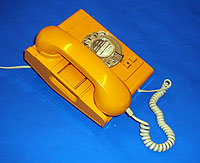 | This is one of the first Ambassador models produced and features a rotary dial with recall button. This yellow example was manufactured PYE, Aidre (GNA) in 1981 (81/1). The side recess designed to make the telephone easy to hold and carry can be readily seen in this photograph. |
Ambassador 8204R
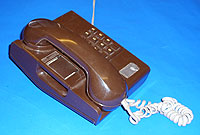 | This example of the Ambassador in brown is a mark 2, reduced cost version and was manufactured by PYE, Aidre (GNA) in 1983 (83/1). Viewed from this angle the recess intended to make the telephone easy to handle and pick up can be seen. |
Ambassador 8204R
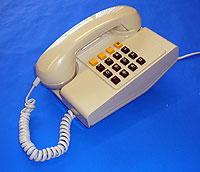 | This cream version of the Ambassador is a Mark 2 - reduced cost version - manufactured by Pye, Aidre, (GNA) in 1984 (84/1). |
Ambassador 8204R
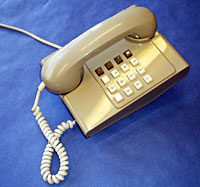 | This grey version of the Ambassador is a Mark 2 - reduced cost version - manufactured by Pye, Aidre, (GNA) in 1984 (84/1). |
Ambassador 8551
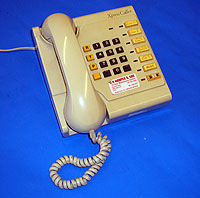 | The version of the Ambassador was designed to be used on the BT Ambassador telephone system.
This example in cream was manufactured by GEC-AEI Telecommunications, Newton Aycliffe, Co. Durham (GEN) in 1985 (85/1) |
The Viscount Telephone
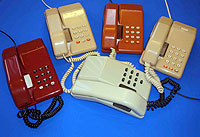 The Viscount range of telephones were developed by STC as their new electronic
telephone and introduced in 1982.
The Viscount range of telephones were developed by STC as their new electronic
telephone and introduced in 1982.
9501 Viscount Telephone
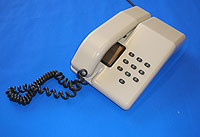 | This is an early version of the Viscount - identifiable by the 10 number keypad without any extra buttons. This ice grey version was manufactured by the Standard Telephone Company, Belfast, Northern Ireland (STM) in 1982. |
9511R Viscount Telephone
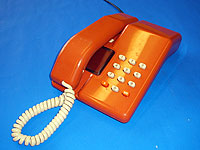 | A later model of the Viscount featuring a 12 number keypad. The additional buttons provided a secrecy (S) button that cut-out the microphone and a MR button which provided a last number re-dial function. This orange version was manufactured by the Standard Telephone Company, Belfast, Northern Ireland (STM). |
9511R Viscount Telephone
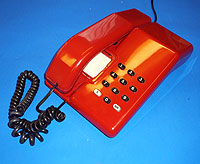 | Another example of the 9511R, 12 number keypad Viscount; this time in red. Manufactured by the Standard Telephone Company, New Southgate, London (STC). |
9511R Viscount Telephone
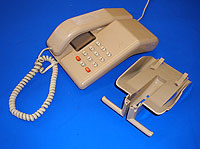 | This example of the 9511R in beige is also supplied with a wall mounting bracket. Manufactured by the Standard Telephone Company, New Southgate, London (STC). |
9511R Viscount Telephone
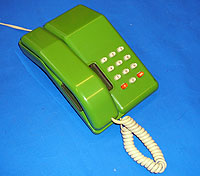 | Another example of the 9511R, 12 number keypad Viscount, this time in green. It was manufactured by the Standard Telephone Company, Belfast, Northern Ireland (STM), in 1985 (85). |
9631AR Viscount Telephone
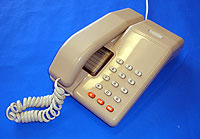 | This is a Viscount Super 4 Telephone which offered additional features. The button at the top of the telephone provided an on-hook amplifier. A four number memory could be stored by pressing the MS button followed by a number 1-4 and then activated by using the MR button. The N button provided a last number redial function. This memory is retained through the use of internal batteries. This beige model was manufactured by the Standard Telephone Company, Belfast, Northern Ireland (STM). |
The Viscount Telephone
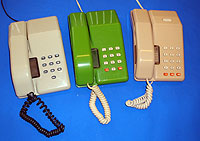 | Shown here are three examples of the Viscount telephone.
On the left is the basic 9501 model with the 10 digit numeric keypad. In the middle is a model 9511 with the added secrecy and last number re-dial buttons. Finally, on the right is model 9631 with the full 15 key keypad. |
Digitel 2000 Kirk Loudspeaking Telephone
 | The Digitel 2000, 'Kirk' telephone was designed and manufactured by Horsens of Denmark. It provided a hands-free operation mode with a microphone and loudspeaker located within the telephone case. A volume control is located on the back of the handset. It became available in the UK in the early 1980s. |
GPO Trimphone 8766 - push button
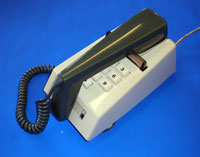 | The first keypad versions of the Trimphone became available in the late 1970s. The additional electronics necessitated increasing the height of the body over the rotary dial version. This example of the Trimphone was manufactured by the GPO Factory in Cwmcarn, Wales (FWR) in 1982. |
TSR 8012 Rhapsody Telephone
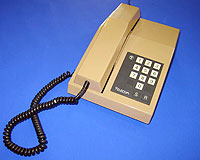 | Designed by Atea of Belgian these early push-button telephone were manufactured by GTE in 1982 and marketed within the Telephone Special Range (TSR) as the Rhapsody. |
The Statesman Telephone
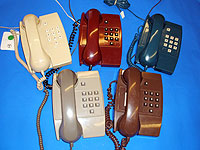 The Statesman started out life as the Inexpensive Telephone developed by
GEC, Plessey and Pye. It was a simplified version of the Ambassador and
became one of the most successful customer telephones of the 1980s.
The Statesman started out life as the Inexpensive Telephone developed by
GEC, Plessey and Pye. It was a simplified version of the Ambassador and
became one of the most successful customer telephones of the 1980s.
Statesman versions
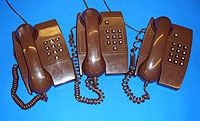 | Shown here are three examples of the Statesman telephone in brown. On the left is a model 9001 with its basic numeric keypad; in the middle is model 9003R which provides the additional Recall button; and finally on the right is model 9101R which has the additional star and hash keys. |
Statesman 9001
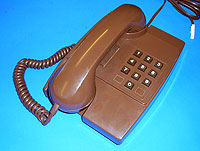 | This is the most basic version of the Statesman with no additional features other than a standard ten digital keypad. This brown model was manufactured by Pye, Aidre (GNA) in 1983 (83/1). |
Statesman 9003 R
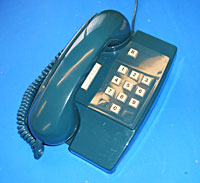 | This blue version of the Statesman is a model 9003R which was manufactured by Plessey at their Beeston factory in Nottinghamshire (EET) in 1983 (83 Nov). |
Statesman 9101R
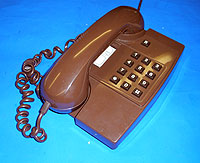 | This brown version of the Statesman is model 9101R fitted with the additional star and hash keys. It was manufactured by Pye, Aidre (GNA) in 1983 (83/1). |
Statesman 9003R
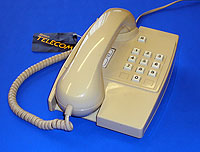 | This cream version of the Statesman is a model 9003 which included a recall button for use on private exchanges. It was manufactured by Plessey at their Beeston factory in Nottinghamshire (EET) in 1984. |
Statesman 9003 R
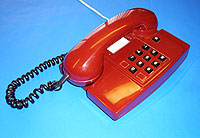 | This maroon version of the Statesman is a model 9003R which included a recall button for use on private exchanges. It was manufactured by Pye, Aidre (GNA) in 1985. |
Statesman 9003R
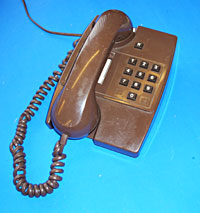 | This brown version of the Statesman is a model 9003R which was manufactured by GEC-AEI Telecommunications, Newton Aycliffe, Co. Durham (GEN) in 1985 (85/1) |
Statesman 9003R
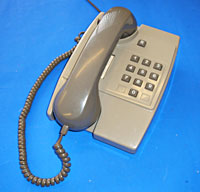 | This grey version of the Statesman is a model 9003R which was manufactured by Plessey at their Beeston factory in Nottinghamshire (EET) in 1985 (85-09) |
Statesman 9040 R
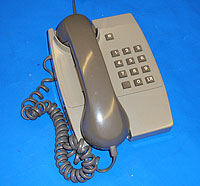 | This grey version of the Statesman is a model 9040R which is a basic model with the added feature of a last number re-dial (LR). This example was manufactured by GEC-AEI Telecommunications, Newton Aycliffe, Co. Durham (GEN) in 1986 (86/1) |
Statesman 9040 R
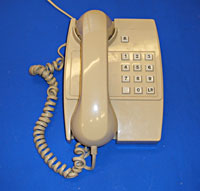 | This cream version of the Statesman is a model 9040R which is a basic model with the added feature of a last number re-dial (LR).
This example was manufactured by GEC-AEI Telecommunications, Newton Aycliffe, Co. Durham (GEN) in 1986 (86/1). |
The Genie
The "Genie" Telephone
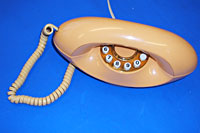 | This version of the Genie is in Peach. It was manufactured for BT by A.P. Besson Ltd - Hove, Sussex (DAE) in 1983 (83/1). It also carries the Telephone Special Range marking TSR8022A. |
The 'Genie' Telephone
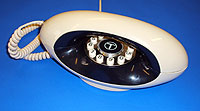 | Originally manufactured by the American Telecommunications Corporation (ATC) of El Monte, California. It was released in the UK as part of the Telephone Special Range as number 8023, Genie, in 1983. Although the keypad is arranged in the form of a dial, it actually a push button telephone with last number re-dial and had electronic tone ringer, not a bell. |
Dialatron Carrera 1 Push Button Telephone
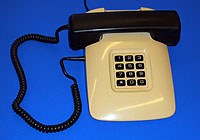 | Designed and made by Iskra, Yougoslavia for Dialatron UK and released in the 1980s. |
Sceptre 100
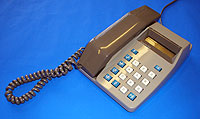 | The Sceptre was designed by BT and provided an LCD display, 10 number memory, clock, a call timer and last number re-dial. The clock was maintained by separate batteries. This version was manufactured by Denis Ferranti Meters Ltd., Bangor, Gwynedd (DFM) in 1984 (1/84) |
10005R Venue 24 Telephone
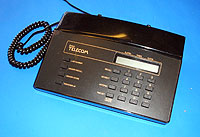 | The Venue 24 telephone was derived from the Sceptre telephone. It contained a 24 number store, a clock, call timer and alarm.
The LCD display also showed the number being dialled. Internal batteries were required and a 'low battery' warning appears in the display. The Venue was introduced in the mid 1980s. |
Astral 'Fab Phone'
 | Manufactured by Astral International Ltd. It features last number redial, an electronic ringer and is hearing aid compatible. This model is presented in the Acid Lime colour. |
Betacom ITALIA Model No. IT/2
 | A phone that could be either wall mounted or simply rested on a table. |
GEC "Gallery" Telephone
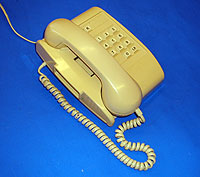 | This GEC Gallery Telephone has much in common with the Statesman and could have been an early version.
It differs from the other models in having a side recess, not that dissimilar to the Ambassador, and embossing around the keys and handset recesses. It was manufactured by GEC-AEI Telecommunications, Newton Aycliffe, Co. Durham (GEN) in 1986 (86) |
The Tribune Telephone
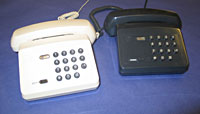 The Tribune range was introduced by BT in the mid 1980s. Its compact design featured a push button keypad and a traditional bell ringer or tone caller. It was offered in three main ranges 94xx, 98xx and 99xx.
The Tribune range was introduced by BT in the mid 1980s. Its compact design featured a push button keypad and a traditional bell ringer or tone caller. It was offered in three main ranges 94xx, 98xx and 99xx.
9804AR Tribune Telephone
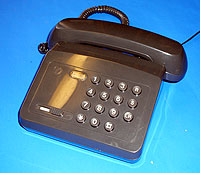 | The Enhanced Tribune Telephone provided a neon light to show incoming calls and an amplified receiver with adjustable volume control. They were also fitted with an adjustable bell. This grey version was manufactured by Denis Ferranti Meters Ltd (DFM) and became available in 1988. |
9810AR Tribune Telephone
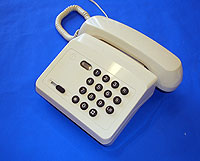 | This Enhanced Tribune Telephone is a modified version of the 9804AR offering a higher degree of receiver amplification. This white version was manufactured by Denis Ferranti Meters Ltd (DFM) and became available in 1988.
|
The Tremolo Telephone
9701 Tremolo Telephone
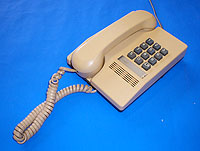 | Manufactured by Northern Telecom, the Tremolo was introduced in 1988. It provided a last number re-dial and secrecy button. |
9701 Tremolo Telephone
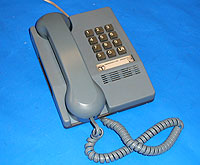 | The Tremolo was introduced in 1988 as a standard residential telephone. This model in grey was manufactured by STC Consumer Electronics, Cwmcarn, Wales (FWG).
|
Featurephone TX21
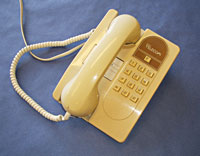 | The Featurephone was designed to work with the Octara 32 key telephone system. This model is a basic handset and was manufactured by GEC Plessey plc in 1989 (89/18). |
Thorn Ericsson TET
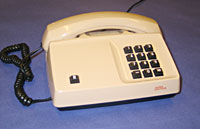 | A TR100 Diavox Telephone Instrument manufactured in 1989 (89/05). |
The React Telephone
BT Tele 5012AR React Push Button Telephone
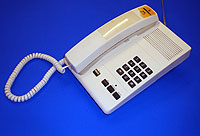 | This is the basic model in the React range. It provides secrecy and last number re-dial plus private exchange functions such as recall. The React range was introduced in 1990. |
BT Tele 5013AR React Push Button Telephone
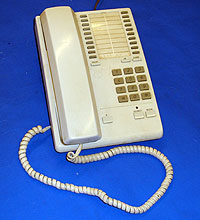 | This is a model React 120 with 20 address buttons for pre-stored numbers. It was introduced in 1990.
|
The Vanguard Telephone
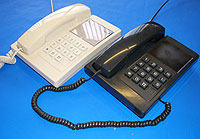 The Vanguard model was introduced in the early -1990s as the main customer
rental telephone. They provided last number re-dial and secrecy functions and
could be switched between pulse or touch tone dialling.
The Vanguard model was introduced in the early -1990s as the main customer
rental telephone. They provided last number re-dial and secrecy functions and
could be switched between pulse or touch tone dialling.
4001AR Vanguard Telephone
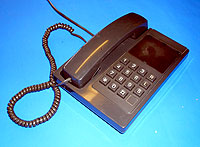 | This basic model of the Vanguard is presented in charcoal grey and was manufactured by STC Consumer Electronics, Cwmcarn, Wales (FWG) in 1992. |
4001AR Vanguard Telephone
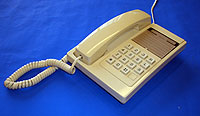 | This basic model of the Vanguard is presented in polar white and was manufactured by STC Consumer Electronics, Cwmcarn, Wales (FWG) in 1992. |
4001AR Vanguard Telephone
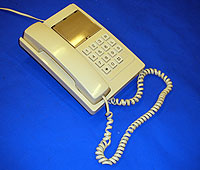 | Another example of the 4001AR Vanguard basic model in polar white. It was manufactured by STC Consumer Electronics, Cwmcarn, Wales (FWG) in 1992. |
4003AR Vanguard Telephone
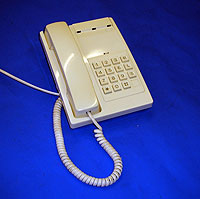 | This 4003AR model of the Vanguard is presented in polar white and was fitted with an inductive coupler. This is compatible with behind-the-ear hearing aids when these are switched to the 'T' position. It was manufactured by STC Consumer Electronics, Cwmcarn, Wales (FWG) in 1992. |
4005 Vanguard 10E
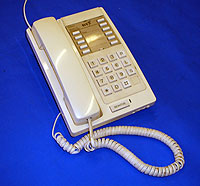 | The Vanguard 10E provides the following additional features over a standard Vanguard, on hook dialling (with switchable Monitor volume), 10 dedicated memory keys (24 digits) and latching secrecy button in 1992.
|
The Relate Telephone
BT Relate 100
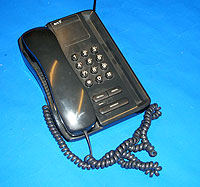 | The Relate 100 was introduced in 1992. It featured a Secrecy Button (with LED), last number redial, ringer volume control (Hi/Lo/Off), and touch tone dialling. The Relate 100 provided the added feature of a pen tray on the right hand side of the case. |
BT Relate 300
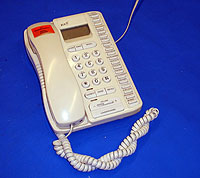 | The Relate 300 was introduced in 1992. It featured a Secrecy Button (with LED), last number redial, ringer volume control (Hi/Lo/Off), and touch tone dialling. This model provided the additional features of
full hands-free operation, 20 quick dial keys, and an LCD panel with clock and call timer. |
BT Relate 2000 Videophone
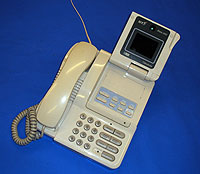 | This Relate 2000 videophone was the first one BT made commercially available, in the 1990s. It promised callers the chance to see, and be seen by, the person they were talking to. It features a flip-up screen on the right, where the video played. They were available for £500. The colour Liquid Crystal Display is a 2.9" screen which displays the incoming video signal at a rate of 8 frames per second. If the picture is unclear due to line noise or other interference, the rate may be slowed to 3-4 frames per second. Unfortunately picture quality generally proved to be poor and the videophone was not popular. |
BT "Moneybox" CT6000B
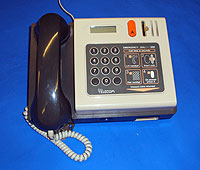 | This BT payphone was supplied for use within residential premises. |
Duet 200 Telephone
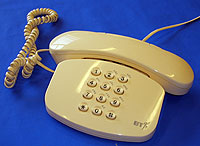 | The Duet contained a 13 number memory, last number re-dial, ringer volume control and an LCD display concealed under the handset. This model is marked Made in Malaysia and became available in the early 1990s. |
Solitaire 2000C payphone
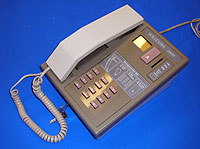 | This model was manufactured by GN Rathdown Ltd. A payphone that required a customer to insert coins before making the call. These coins were collected in a tray under the telephone that was locked by a key. This model promotes the fact that it accepts the new smaller size 10p coin which dates it at 1992. When the person answers you press 'button A' to establish the call in the same way as the old Button A and B telephone boxes. There is no button B here, just a coin reject button. |
The Converse Telephone
BT Converse 100
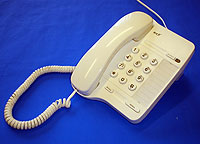 | The Converse range of telephones were introduced for this business market. This Converse 100 model was introduced in 1994. It features a recall button which allows incoming calls to be transferred to another user via a company's private telephone exchange. |
BT Converse 100
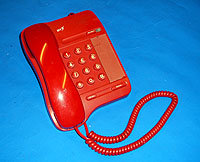 | The Converse range of telephones were introduced for this business market. This red Converse 100 model was introduced in 1994. It features a recall button which allows incoming calls to be transferred to another user via a company's private telephone exchange. |
BT Converse 400
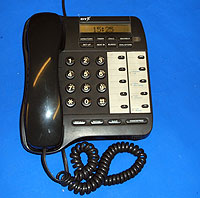 | Launched in 1997 the Converse 400 was intended to replace the Relate and Vanguard ranges with the Converse being intended for business use. |
BT Converse 120 Push Button Telephone
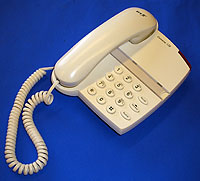 | The Converse 120 is a basic function telephone for the business market. Introduced in 2001 it features an illuminated incoming call indicator, recall, redial and secrecy functions. |
Converse 125
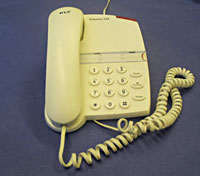 | The Converse 125 was launched in 2003 and is a basic telephone with call indicator light and ringer volume control. It has the added benefit of a data port for the direct connection of a modem. |
BT Converse 1200 Push Button Telephone
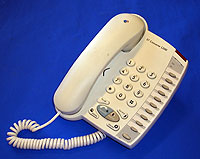 | Introduced in 2007, the BT Converse 1200 is a desk telephone with hands-free operation, and the provision of ports for an external headset and data connection. It can store 10 numbers accessed via the individual buttons on the right hand side of the unit. This memory is able to retain its contents for 3 minutes without power. It also has recall, redial and secrecy buttons, a ring indicator and volume controls. |
GPT Connect 1 Plus, Mercury Communications
 | Mercury Communications was created in 1982 to compete with British Telecommunications plc. By the mid 1990s it offered an alternative telephone service to residential customers. Shown here are two examples of Mercury branded telephones that contained the 'blue' Mercury button which routed calls to the Mercury, rather than BT network. |
Guernsey Telecom 100 Anniversary Telephone
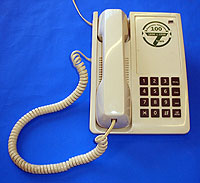 | A special telephone manufactured by Pocket (UK) Ltd Manchester in April 1996 to celebrate the 100th anniversary of Guernsey Telecom (1896-1996). |
STC 200
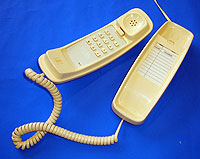 | A basic wall mounted telephone. |
The Decor Telephone
Decor 200
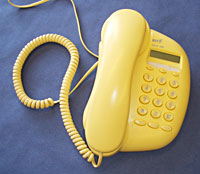 | The Decor range of telephones was launched with the Decor 100 in 1999. This is a Decor 200 in yellow which was released in 2000. It featured a 13 number memory, a LCD to show the number dialled, re-dial and batteries which allowed the number memory to be retained for 4 hours when unplugged from the telephone network. |
Decor 310
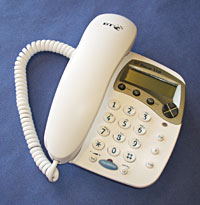 | The Decor 310 was released in 2003. It features an extended LCD that displays the time and date, the number being dialled including the name of the person if you have entered this into the memory, a voice message alert icon, battery status and the number of an incoming call if the user has subscribed to BT's Caller Display service. It includes re-dial, and hands free operation with separate volume control. A total of 30 numbers together with names can be stored in the memory and organised within directory groups, each of which can be differentiated by a different ringer tone. In addition it provides an alarm clock function and automatically records the time and duration of all calls. |
Decor 1100
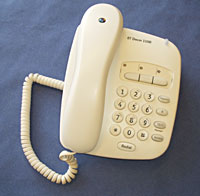 | The Decor 1100 was released in 2005. It can store up to 13 numbers accessed through 3 one-touch memory buttons and the remaining 10 accessed using a memory button and numeric keypad. It has a last number re-dial and a "1571" button that flashes if a voicemail has been received on the BT 1571 service. It requires four AA batteries for power.
|
Binatone Avon 400
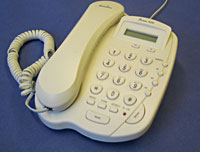 | The Binatone Avon 400 was introduced in 2001 and offers three memories that can store 13 digit numbers, call timer, built in clock, LCD display and redial. |
Berkshire SD14 Telephone
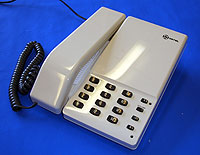 | Manufactured by ATL Telecom in 2002, the SD14 offers last number redial, volume control, secrecy, visual call indicator, and recall. |
Panasonic VA 30920
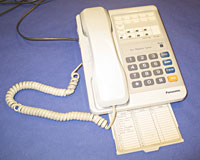 | The Panasonic VA 30920 is designed to work with a Panasonic A series Key Telephone System which provide a standard range of office switchboard functions. |
Doro X20
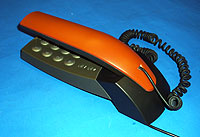 | This stylist Doro X20 wall phone in terracotta was introduced in 2005. It features 10 memories, 3 ringers with 3 settings for each ringer, handset volume control and last number redial. |
Binatone Speakerphone 100
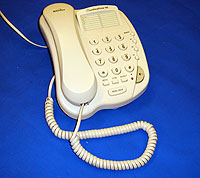 | Corded phone with speaker
The Speakerphone 100 is a two peice speakerphone and 13 memories and a handsfree capability. Presented in a white it is a new addition to the Binatone range of speakerphone telephones suitable for the home or office. |
Cisco IP Phone 7912 series
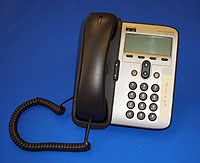 | The Cisco 7912 is a basic level IP telephone. These telephones use voice-over-IP (VoIP) technology to send voice calls over data networks that run the Internet Protocol (IP). An example of the trend towards converged networks; one network infrastructure offering all customer services. |






